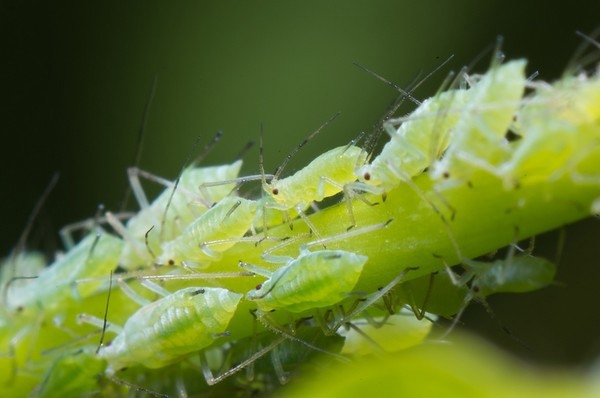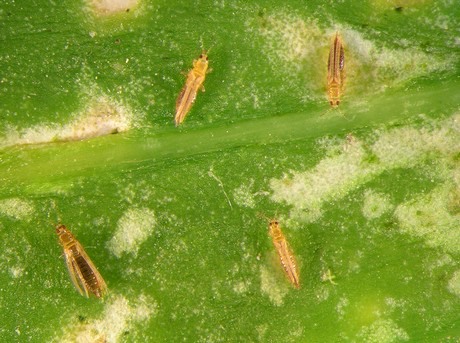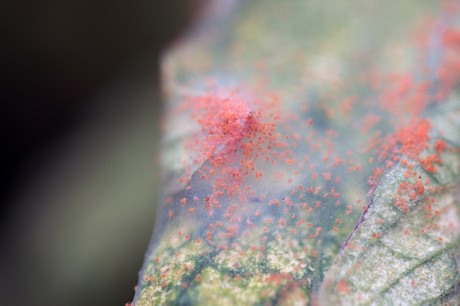In this new article series sponsored by Hawthorne Gardening Company, we are going to explore the biggest enemies of growers: pests. With today’s article, we start investigating the most dangerous pests for crops such as cannabis, lettuce, saffron, and so on, and how they ravage our favorite plants. In the next articles of this series, we will talk about best prevention practices, and about scouting and monitoring. But before we get to how to repel these attackers, we first have to know them!
Considering the environmental conditions needed to cultivate plants indoors, it doesn’t come as a surprise that greenhouses represent a perfect breeding ground for pests to develop. Because of that, early detection and diagnosis of pest insects are necessary to make control decisions before the problem gets out of hand and growers suffer economic loss. Some common and important greenhouse arthropod pests to keep a close watch for are: aphids, fungus gnats, thrips, whiteflies, root aphids and mites. The most frequently observed diseases are: powdery mildew, botrytis, pythium and fusarium.
Aphids
“Aphids (Hemiptera: Aphididae) are a typical insect pest of greenhouses which feed on a wide variety of plants by piercing leaf cells and sucking out their contents by means of their stylets,” Ian Bateman, technical service manager at Hawthorne Gardening Company. “Aphids also work as vectors for plant viruses, and they release honeydew waste products that can be spotted on leaves that appear as translucent, or wet spot. When a plant is heavily infested, other than the translucent spots, leaves can turn yellow as well as white skin residues can be found. Additionally, wet spots become a perfect breeding ground for mold or fungal diseases.”
Thrips
Thrips (Thysanoptera: Thripidae) are a severe insect pest of greenhouses which feed on a wide variety of plants by piercing surface cells of leaves and sucking out the cell contents by means of their stylets. “Thrips also have a very rapid life cycle, which allows for multiple generations per year,” Ian explains. “At the end of the second larval stage, thrips enter the soil or leaf litter. Thrips tend to feed on buds and new leaves – and generally speaking, they prefer to feed on the upper leaf surface of plants. Bronze or silvery leaf scars and tiny black spots of fecal excrements are evident on leaves with heavy-feeding injury.”
Whiteflies
Whiteflies (Diptera: Aleyrodidae) are white, soft-bodied, winged insects with a triangular shape, and are often found in clusters on the undersides of leaves. “Whiteflies use their piercing, needlelike mouthparts to suck sap from phloem, the food-conducting tissues in plant stems and leaves. Large populations can cause leaves to turn yellow, appear dry, or fall off plants. Like aphids, whiteflies excrete a sugary liquid called honeydew, so leaves may be sticky or covered with black sooty mold that grows on honeydew,” he continues.
Root aphids
Root aphids (some Pemphigus, Phylloxera, and Rhopalosiphum species) vary in color, but most are white, whitish yellow or brown. “Root aphids have piercing, sucking mouthparts that extract sugar-rich sap from underground structures such as roots, bulbs and rhizomes,” Ian points out. “They can produce a white, waxy secretion that covers their body and some is left behind as they move through the growing medium. This is often mistaken for mealybugs that are also covered with a white waxy or threadlike substance. It is best to use a hand lens and observe the roots to see the actual insect. Minor infections of root aphids do not cause significant plant damage, however, as the populations increase, wounds in plant roots can become entry points for root disease pathogens. Plant roots cannot take up nutrients and therefore can exhibit nutrient deficiencies in the leaves. Plants often have a lack of vigor, are smaller and can wilt, especially during the heat of the day. Root aphids do not travel rapidly, so infections are often restricted to a few plants and spread slowly initially.”
Fungus Gnats
Fungus gnats (Bradysia species) are small, delicate-bodied flies that develop in the growing medium. Adults are 3 mm long, delicate, black flies with long legs and antennae. “Larvae primarily feed on fungi, algae and decaying plant matter as well as plant roots,” Ian remarks. “The larvae are wormlike and translucent, with a black head capsule. Larvae usually are located in the top 2 to 3 inches of the growing medium, depending on moisture level. Moist growing media containing high amounts of peat moss are particularly attractive to adult females. Plants infested by numerous fungus gnat larvae can have stunted growth.”
Spider mites
Spider mites (Acari:Tetranychidae) such as the two-spotted spider mite (Tetranichus urticae) are arthropods that feed on a variety of plant species by sucking the plant cell content through a pair of sharp stylets. Spider mites are tiny (approximately 0.5 mm in length) arachnids with 8 legs and a cream color appearance. “Spider mite populations can develop exponentially in a very short period of time. Eggs are laid in clusters on the underside of leaves. The initial stage of colonization commonly starts from the bottom third of the plant. Injury initially appears as stippling or yellowish-reddish brown spots on the leaves which are located in correspondence of the colony clusters typically found on the underside of the leaf. Leaves initially turn yellow and, with high population density, desiccate and die. On mature plants, higher branches and those directly under growing lights are more likely to become infested with spider mites.”
Stay tuned for the second part of this special series on pest management, where we will discuss hemp russet mites, broad mites, powdery mildew, botrytis, pythium, and fusarium!
For more information:
Hawthorne Gardening
hawthorne-gardening.com



